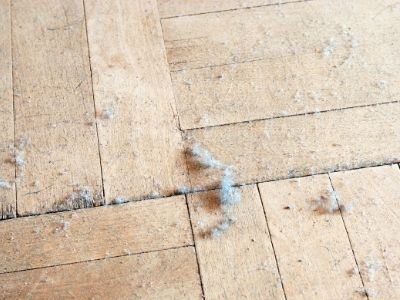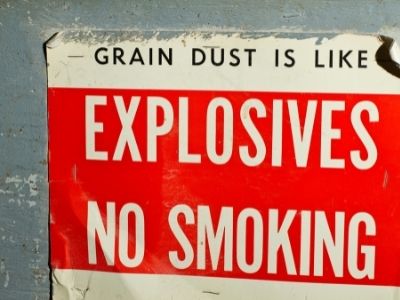Dust is one of those common nuisances when it comes to keeping the home nice and clean. It seems that it isn’t long before a layer starts to build up again. We don’t think much of it until we hear the term “dust explosion” and start to worry that poor dusting habits could be dangerous. So, is dust a fire hazard, and what do we need to watch out for?
It is possible for dust to catch fire and excessive dust can be a fire hazard. However, the risk depends on the composition of the dust and its location. In the worst cases, industrial dust can cause fatal explosions. But, a little bit of common household dust isn’t a major problem.

To better understand the risks of dust catching fire, we need to consider the following issues.
- Why is dust so flammable and dangerous
- What is the difference between household dust and industrial dust
- What dust explosions are
- How to reduce the risk of dust fires
Table of Contents
Why is dust flammable?
When you run your finger over a dusty shelf and feel how small and fragile the pieces are, it is hard to believe they may be dangerous. But, large amounts can be. It all comes down to the ratio of the surface area of a particle and the number of particles in a dust cloud.
Individually they are pretty insignificant, but as a whole, there is a large surface area to burn. The risk then increases if the base material is more flammable, such as particularly dry and combustible one.
So, it is important to look at dust as more than a layer of household dust if we are to fully understand the dangers.
Can household dust catch fire?
Household dust can be a problem if left to get too dry, too build-up, and if it settles in the wrong places. A large build-up of dry dust can form clouds if disturbed and can settle around electrical equipment.
This is when it gets more dangerous as sparks here could cause significant dangerous fires. It is also a material with a large surface area that could potentially accelerate a fire.

However, basic household dust isn’t as dangerous as other forms of dust, such as in industrial settings, because it isn’t as dry. There is more moisture in regular dust because of the high percentage of dead skin cells.
What other types of dust catch fire?
Household dust is the first thing we tend to think of when it comes to dust. But, what about sawdust or the dust created from other industrial processes?
Here we are talking about any mass of dry particles where you end up with a large surface area overall. One that springs to mind is sawdust. We all know from handling DIY equipment that sawdust can be a big problem and we use safety equipment to avoid breathing it in.
But, there are also risks of fires.
The first risk here is that sawdust is very dry and highly combustible. Some people deliberately collect the material, pack it together, and use it as a fire starter.
So, if a fire were to break out in a workshop, such as from an electrical fault, there is the risk that the dust on the ground will act as an accelerant. Then there is the risk that sparks in the air will ignite dry particles of dust floating around.
These particles could be minute, but if there are enough of them you could get a fire or a dust explosion.
It isn’t just sawdust that is a problem. Lots of materials can create dust when ground down into very small particles.
Remember dust doesn’t mean dirt.
It is all about that surface area to volume ratio of small dry particles. One example that you may have in your kitchen is coffee dust, especially if you grind your own coffee for an espresso maker.
At home, this isn’t a big deal and you can wipe away the excess. In industrial settings, a build of coffee dust is more dangerous. In fact, facilities must have industrial vacuum systems in place for health and safety.
A similar threat comes from sugar dust. Again, fine particles of sugar aren’t an issue in a small kitchen. But, it is a different story in sugar factories where it can build into dangerous clouds.
There was a case in Georgia in 2008 where 14 people died in a sugar dust explosion at the Imperial Sugar Factory.

Then there is the risk of dust explosions from coal dust in mines. Coal dust is highly volatile and can create massive clouds in coal mines. These confined spaces become powder kegs where a spark can ignite the dust cloud and cause significant damage and fatalities.
In 2010, 29 miners died this way in a coal mine in West Virginia.
What is a dust explosion?
The term dust explosion has come up a couple of times now concerning those massive fires, so what is a dust explosion?
This is where dust is at its most dangerous as a fire hazard. It all starts with a cloud of airborne particles, such as the fine particles of coffee or sugar circulating in those factories.
If you get a high enough concentration of dust in a small space, with no ventilation, you increase the risk of the combustible material igniting. All it takes is enough pure oxygen and an ignition source for a significant fuel-air explosion.
In the worst cases, these can cause significant damage and fire risk. These situations tend to occur in enclosed spaces with no ventilation, such as mines and elevators in industrial settings. They shouldn’t occur in a well-designed factory setting, but freak accidents can happen.
Technicians have adopted the science behind these dust explosions for various applications.
Surprisingly, there are examples of people using dust explosions deliberately in a controlled environment. Skilled pyrotechnicians can create the effect of a dust explosion for controlled explosions on film sets or in stage shows.
This leads to a violent reaction from a simple substance, but they can control the material and its detonation to remain safe. Technicians in the military also use the principles behind dust explosions within thermobaric weapons.
These bombs saturate a target area with a cloud of combustible material – like a dust cloud – and then deliberately ignite it.
How to prevent dust fires at home.
Thankfully, most of us don’t have to worry about the dangers of dust explosions unless we have a health and safety role in a mine or factory. You are unlikely to create that much sawdust in a garage and your household dust isn’t that dangerous.
Still, it is important to keep on top of household dust to prevent fires and to make sure your garage or workshop is ventilated to reduce the dangers from sawdust.
The best way to prevent dust fires at home is to get into a habit of regular cleaning and to pay attention to where dust settles.
It is a bit of a cliche; to say that small consistent efforts are the key to good housekeeping, but they really can make a big difference when it comes to dust and its threat as a fire hazard. Make sure to dust surfaces regularly and to sweep or vacuum the floor.
Also, consider using a damp cloth where possible to remove the dust rather than sweep it into a new location.

It is also a good idea to pay attention to your electrical items. Wipe down the dust on your appliances, check that no dust bunnies have gotten into the port and outlets, and pay attention to areas around cables and extension cords.
The more often you do this, the less likely it is that dust will build up into dangerous layers.
Finally, check over any items you use infrequently that are just out of storage. An old electric heater could end up harboring some big dust bunnies while in storage for the summer.
Preventing dust fires at work.
Preventing dust fires at work is a little different and all depends on the scale of the operation, the materials used, and the tools available.
If you work with a lot of sawdust or other materials that can create clouds of dangerous particles, make sure that you have adequate ventilation on the worksite. This means effective vents, open windows, and exhausts on machinery.
Cleaning regimes are just as important at work as at home to control any dust build-ups. This is true in any setting.
For example, you want to make sure that rooms with lots of electrical equipment or computers don’t get too dusty where dust bunnies could spark electrical fires.
Is dust a big fire hazard?
To summarize, there aren’t too many major fire risks when it comes to the dust in your home. Regular cleaning, especially around electronics, should be fine. The bigger problems come from drier specks of dust, like sawdust, in industrial settings.
Large deposits and clouds can be dangerous and lead to fires and explosions. Be aware of the risks at home and work and take the best preventative action.